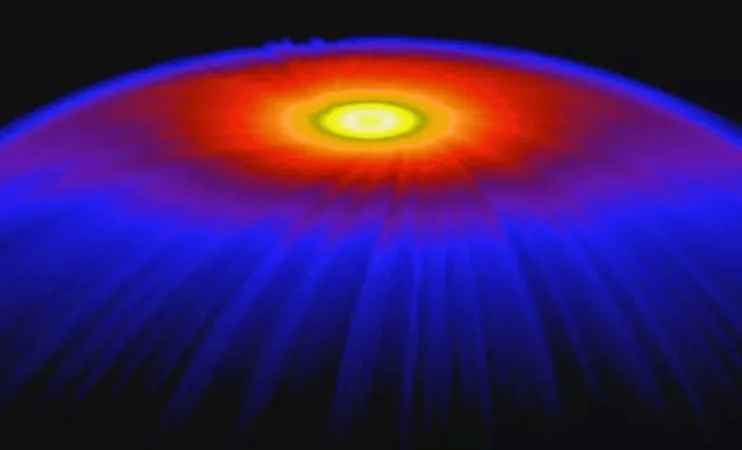
A Stellar Breakthrough: The First Image of a Sunlike Star's Astrosphere Revealed!
2025-01-05
Author: Chun
Astronomers have made a revolutionary discovery by capturing the first-ever image of the astrosphere surrounding a star similar to our sun. This monumental finding revolves around a star affectionately referred to as "The Moth," whose vibrant features and vigorous stellar winds are offering unparalleled insights into the behavior of young stars and their cosmic surroundings. This groundbreaking revelation could help us unlock critical information about the early development of our solar system and the conditions that shaped it billions of years ago.
What Exactly is an Astrosphere?
An astrosphere is essentially a colossal bubble of hot, charged gas that forms when a star’s stellar winds interact with the surrounding interstellar medium. These stellar winds, composed of charged particles in constant motion, create a protective shield that stretches deep into space. In the case of our solar system, this protective layer is known as the heliosphere, which shields Earth and its neighboring planets from hazardous galactic cosmic rays.
Historically, astrospheres had only been observed around massive, dying, or very young stars. Finding such a structure around a sunlike star—especially one that could potentially host planets—has presented a considerable challenge for scientists. Carey Lisse, an astronomer from the Johns Hopkins Applied Physics Laboratory, voiced the importance of this breakthrough, stating, “For 20 years, we’ve been searching for this phenomenon and finally, we have proof.”
Introducing The Moth: A Young Star with Extraordinary Winds
The Moth, or HD 61005, is located roughly 125 light-years away in the constellation Puppis. At about 100 million years old, this star is a youthful sibling to our sun, which is approximately 4.6 billion years old. Younger stars like The Moth are typically far more dynamic, emitting significant stellar winds that profoundly influence their surroundings.
The moniker "The Moth" originates from the unique shape of the star’s debris disk, first observed by the Hubble Space Telescope. This disk, which appears to be swept back into wing-like formations, is thought to arise from the star’s rapid movement through interstellar gas at a staggering speed of around 10 kilometers per second. All these factors made The Moth an exceptional candidate for detecting an astrosphere.
Revealing the Cosmic Bubble: Observations and Their Importance
Using NASA’s Chandra X-ray Observatory, researchers detected a luminous halo of X-ray light encircling The Moth. This halo extends for approximately 100 astronomical units (AU) from the star—about 100 times the distance between Earth and our sun. The X-ray emissions pinpoint the boundary of the star’s astrosphere, where stellar winds collide with interstellar matter.
Interestingly, unlike the wing-shaped debris disk, the astrosphere itself appears remarkably spherical, signifying that the star’s stellar winds are exceptionally powerful. Lisse pointed out the relevance of this finding by stating, “The astrosphere is revealing insights into our sun’s past. We were like this once.”
The investigation into this astrosphere offers a rare glimpse into the primordial conditions of our solar system. The young sun, similar to The Moth, likely had intense stellar winds that helped shape the early heliosphere, thus influencing the environments where planets began to form.
The Impact on Planetary Habitability
The research on astrospheres surrounding sunlike stars has profound implications for understanding planetary habitability. Stellar winds are integral to determining whether conditions are suitable for life to flourish on planets. For instance, an astrosphere can act as a protective barrier against harmful cosmic radiation, engendering a more stable environment for life to develop. Conversely, increased stellar activity could potentially erode planetary atmospheres, making survival challenging for any potential life forms.
This discovery may also provide fresh insights into the origins of life on Earth. By examining The Moth, scientists can recreate the early conditions of our solar system, highlighting how the youthful sun’s astrosphere may have influenced the development of environments conducive to life.
Stay tuned as scientists continue to unravel the mysteries of our universe, one star at a time! This breakthrough opens up new avenues of research that could transform our understanding of life beyond Earth. What will we discover next? Keep your eyes on the cosmos!


 Brasil (PT)
Brasil (PT)
 Canada (EN)
Canada (EN)
 Chile (ES)
Chile (ES)
 Česko (CS)
Česko (CS)
 대한민국 (KO)
대한민국 (KO)
 España (ES)
España (ES)
 France (FR)
France (FR)
 Hong Kong (EN)
Hong Kong (EN)
 Italia (IT)
Italia (IT)
 日本 (JA)
日本 (JA)
 Magyarország (HU)
Magyarország (HU)
 Norge (NO)
Norge (NO)
 Polska (PL)
Polska (PL)
 Schweiz (DE)
Schweiz (DE)
 Singapore (EN)
Singapore (EN)
 Sverige (SV)
Sverige (SV)
 Suomi (FI)
Suomi (FI)
 Türkiye (TR)
Türkiye (TR)
 الإمارات العربية المتحدة (AR)
الإمارات العربية المتحدة (AR)